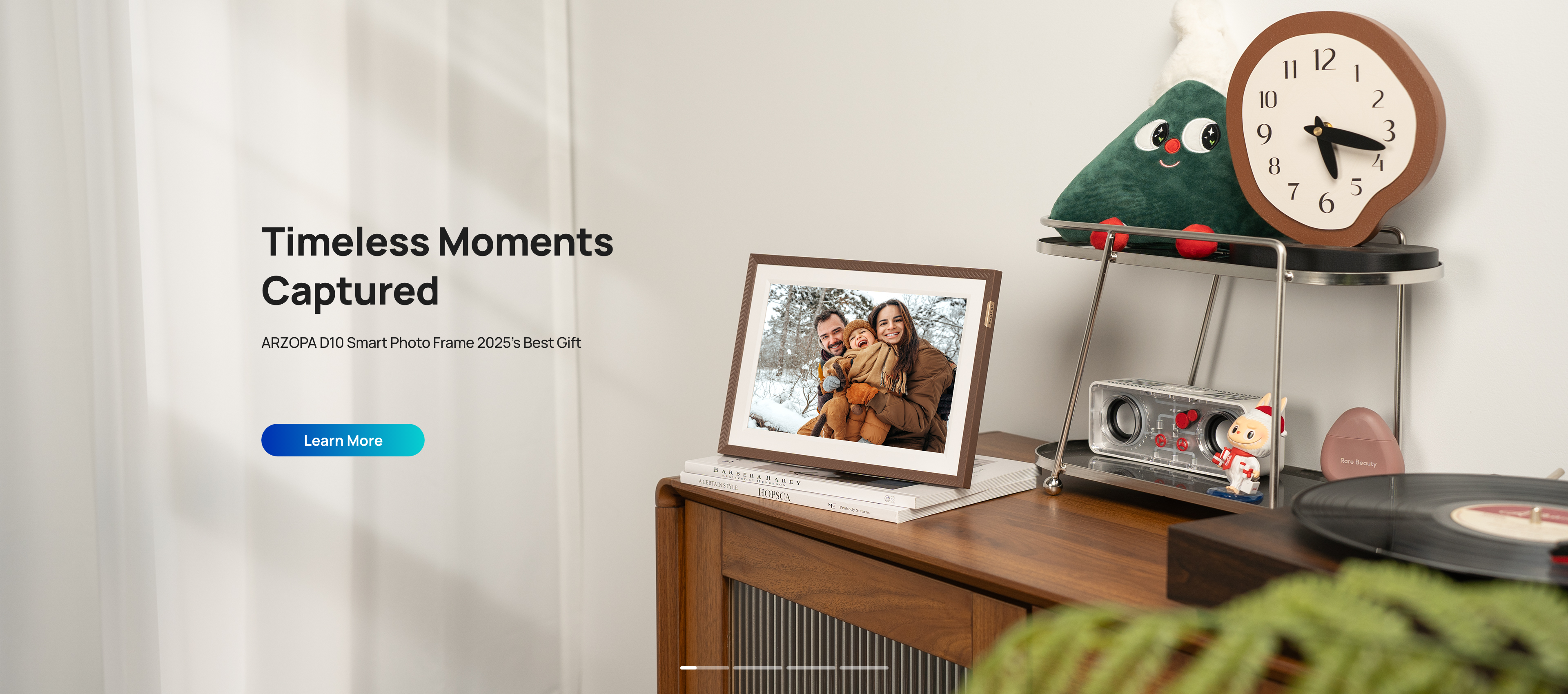Creating a DIY digital picture frame is a rewarding project that combines technology with a personal touch, allowing you to display your favorite digital memories in a unique and customizable way.
This detailed guide will walk you through everything you need to know to create your own digital picture frame, including the materials and tools required, a step-by-step guide to assembling your frame, the pros and cons of going the DIY route, and recommendations for the most cost-effective digital picture frames with WiFi capabilities.
Materials and Tools for Your Digital Picture Frame Project [Around $140]
Raspberry Pi or Another Microcontroller:: The microcontroller is the brain of your digital picture frame, controlling how and when your photos are displayed. Depending on the specifications you need, the cost can vary significantly. For instance, a Raspberry Pi Zero W starts at around $10, while more powerful models may range up to $50.
LCD Monitor or Screen: Selecting the right screen size is crucial for your digital picture frame. Ensure that it has an HDMI port for compatibility with your chosen microcontroller. Prices for LCD monitors can vary widely based on size and quality. Budget-friendly options start around $50, but larger or high-resolution screens can cost several hundred dollars.
Frame: You have the option to repurpose an old picture frame or purchase a new one, making sure it fits the dimensions of your chosen LCD screen. The cost depends on whether you're using an existing frame or buying a new one. Secondhand frames can be free or inexpensive, while new frames typically range from $10 to $50 or more.
Micro SD Card: This memory card is essential for storing the operating system and your digital photos. It's recommended to choose a micro SD card with sufficient capacity (at least 16GB). A basic 16GB microSD card costs around $10.
Power Supply: Match the power supply to meet the requirements of your screen and microcontroller, ensuring it provides stable voltage and current. A reliable power adapter typically costs between $10 and $20.
HDMI Cable: This cable connects your microcontroller (e.g., Raspberry Pi) to the screen. Choose a length that suits your setup needs. Basic HDMI cables start at around $5.
USB Keyboard and Mouse: These are necessary for the initial setup of your microcontroller. Any standard USB keyboard and mouse will work. If you don’t already own these, a basic keyboard and mouse combo costs around $20.
Basic Tools: You will need some basic tools for assembly and possibly modifications:
- Screwdriver: For assembling the frame or making adjustments.
- Saw (optional): Only if you need to resize the frame.
- Drill (possibly): Needed if you create holes for mounting components. The cost varies depending on the tools you already have.
Optional WiFi Dongle: If your microcontroller doesn't have built-in wireless functionality, a WiFi dongle can add this capability, useful for remote updates and connectivity. A basic WiFi dongle costs around $10.
Remember that prices can vary based on brand, location, and availability. Be sure to shop around and compare options to find the best deals for your digital picture frame project! 📸💡
How to Make a Picture Frame [Step-by-Step Guide]
Step 1: Preparing the Screen
First, remove any unnecessary components from your LCD screen to fit it into your chosen frame. This might involve disassembling the screen casing and removing the stand.
Step 2: Setting Up the Microcontroller
Install the operating system on your Raspberry Pi using another computer. There are many tutorials available online to guide you through this process. Once installed, configure the Pi to display your photos, either from a connected USB drive or via a cloud storage solution.
Step 3: Assembling the Frame
Fit the LCD screen into your frame. You may need to modify the frame to ensure a snug fit, using tools like a saw or drill. Once the screen is in place, secure it with screws or another fastening mechanism.
Step 4: Software Configuration
Configure the software to display your photos. You can use slideshow software or write a simple script to cycle through images stored on your memory card. Customize settings to fit your preferences, such as display duration for each photo and transition effects.
Step 5: Mounting and Final Adjustments
Decide where your digital picture frame will live and mount it accordingly. Make any necessary adjustments to the software or frame placement to ensure optimal viewing.
Pros and Cons of DIY Digital Picture Frame
Pros:
- Customization: DIY allows you to create a frame that perfectly matches your aesthetic and functional needs.
- Satisfaction: There's a unique sense of satisfaction that comes from building something with your own hands.
Cons:
- Time-Consuming: The process can be time-intensive, from gathering materials to configuring the software.
- Technical Challenges: Those with limited technical experience may find certain steps challenging, particularly the software setup.
- Maintenance: DIY projects may require ongoing maintenance or troubleshooting.
Is It Worth Buying A Digital Photo Frame?
Absolutely! If you’re not up for building a digital picture frame from scratch, consider an alternative that’s both cost-effective and user-friendly: the Arzopa digital picture frame.

Here’s why Arzopa Digital Photo Frame is an excellent choice:
WiFi Connectivity
The Arzopa digital picture frame seamlessly integrates with your home network via WiFi. No more fussing with USB drives or memory cards. Simply connect the frame to your wireless network, and it becomes a dynamic canvas for your memories.
Multimedia Versatility
Not limited to static photos, the Arzopa frame supports a wide range of multimedia formats:
- Photos: Display your favorite snapshots, family portraits, and travel memories.
- Videos: Relive special moments by playing video clips directly on the frame.
- Slideshow Mode: Set up custom slideshows with transitions, music, and personalized timing.
- Whether it’s a serene landscape, a joyful family gathering, or a heartwarming video message, the Arzopa frame brings your memories to life.
User-Friendly Interface
Navigating the Arzopa frame is as intuitive as flipping through a photo album:
- Touchscreen Controls: Swipe, tap, and adjust settings effortlessly.
- Auto-Rotate: The frame automatically adjusts the orientation of your photos based on how it’s positioned.
- Customization Options: Choose display modes, transition effects, and even add captions to your photos.
And don’t worry about technical jargon—the Arzopa frame keeps things simple, so you can focus on relishing your memories.
Sleek Design
The Arzopa frame boasts a sleek, minimalist design that complements any decor. Whether it graces your living room, bedroom, or office, it adds a touch of elegance while showcasing your cherished moments.
Energy-Efficient
Concerned about energy consumption? The Arzopa frame is designed with efficiency in mind. It automatically adjusts brightness based on ambient light conditions, saving power without compromising visual quality.
Remote Control
Sit back and control your frame from across the room. Adjust settings, switch between photos and videos, or pause the slideshow—all with the included remote control.
Auto-On/Off
Set specific hours for the frame to turn on and off. Wake up to a delightful photo display in the morning, and let it rest during the night.
Expandable Storage
The Arzopa frame supports external storage devices, so you can load up even more memories. Whether it’s a USB drive or an SD card, you’ll never run out of space.
With so many features, there is no doubt that the Arzopa digital picture frame offers hassle-free convenience and flexibility for showcasing your cherished memories. 📸🖼️
Conclusion
Creating a DIY digital picture frame offers customization but requires technical skill and time. For a simpler solution, consider the Arzopa digital picture frame - cost-effective and easy to use. Its WiFi capability ensures that your photo display is always up to date, making it a fantastic way to keep your memories alive and visible.
If you have any other questions or insights, feel free to leave them in the comment section below!












